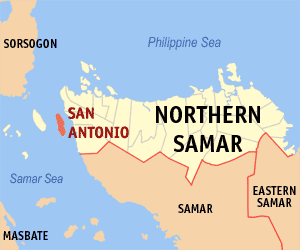
San Antonio, Northern Samar
Encyclopedia

Philippines
The Philippines , officially known as the Republic of the Philippines , is a country in Southeast Asia in the western Pacific Ocean. To its north across the Luzon Strait lies Taiwan. West across the South China Sea sits Vietnam...
. According to the 2007 census, it has a population of 8,151 people.
History
San Antonio was established in 1904. Since its inception, stories have been told that the place was named three times before it was called San Antonio.San Antonio is known as a sanctuary of fish and birds, which is why settlers from the mainland of Samar in the start of 19th century found this place an ideal ground for fishing and hunting. They come to the island just to catch fish and hunt birds and go back after a handful of catch. People from Bohol
Bohol
Bohol is an island province of the Philippines located in the Central Visayas region, consisting of Bohol Island and 75 minor surrounding islands. Its capital is Tagbilaran City. With a land area of and a coastline long, Bohol is the tenth largest island of the Philippines...
and Cebu
Cebu Island
Cebu is an island of the Philippines. It is the main island of Cebu Province at the center of the Visayan Islands, south of Manila.It lies to the east of Negros Island; to the east is Leyte and to the southeast is Bohol Island. It is flanked on both sides by the Cebu Strait and Tañon Strait...
came to the island in the second half of the 19th century and introduced a method of catching fish using net, commonly known as "laya". With its introduction, the name "Manoglaya" was born, which literally means "mano nga paraglaya" or fishermen using laya.
As new settlers came and built new communities in the island, they changed its name to "Sugod-sugod", a Cebuano derivative meaning "just to start or begin". The name was changed to "Matabia", referring to the knife-shape of the island. No one knows now why it was changed that way, neither folklores nor historical data reveal the ways and wherefore of the change. Having no particular preference to immortalize name without great significance, Christians decided to change the name to San Antonio and set Saint Anthony of Padua as their patron saint.
Barangays
San Antonio is politically subdivided into 10 barangayBarangay
A barangay is the smallest administrative division in the Philippines and is the native Filipino term for a village, district or ward...
s.
- Ward I (Pob.)
- Ward II (Pob.)
- Ward III (Pob.)
- Burabod
- Dalupirit
- Manraya
- Pilar
- Rizal
- San Nicolas
- Vinisitahan

